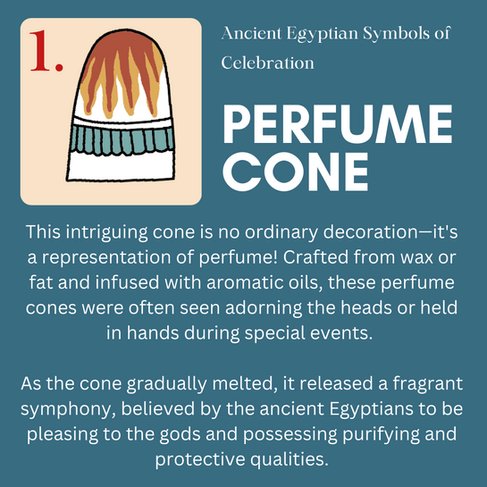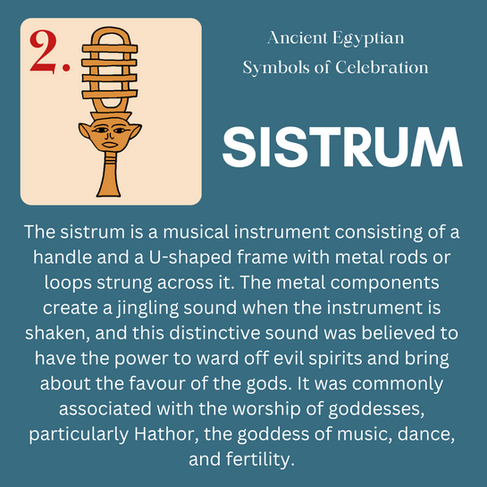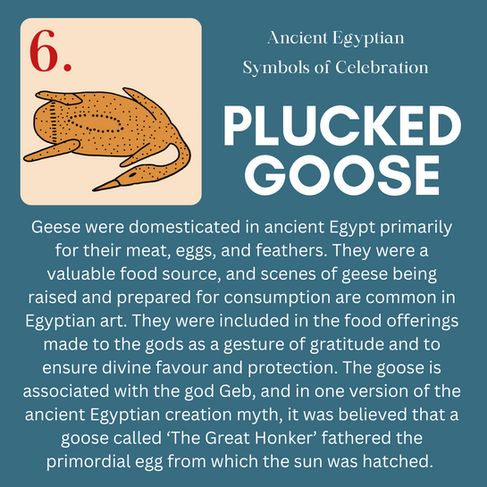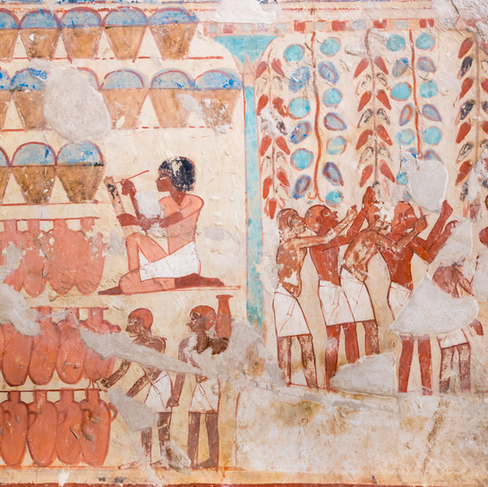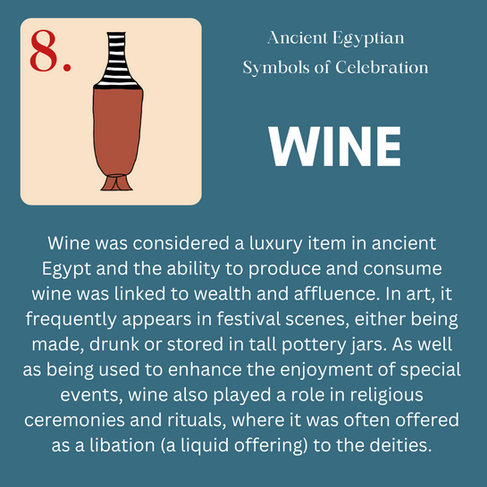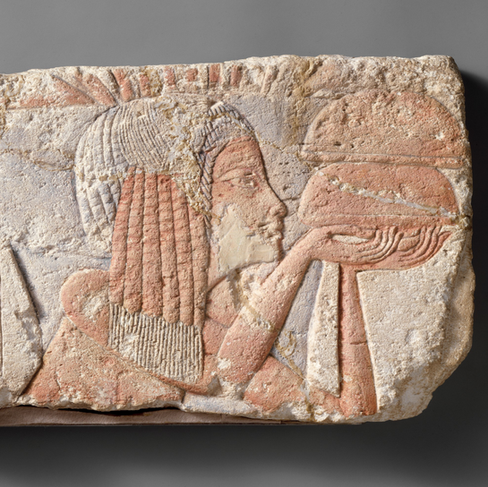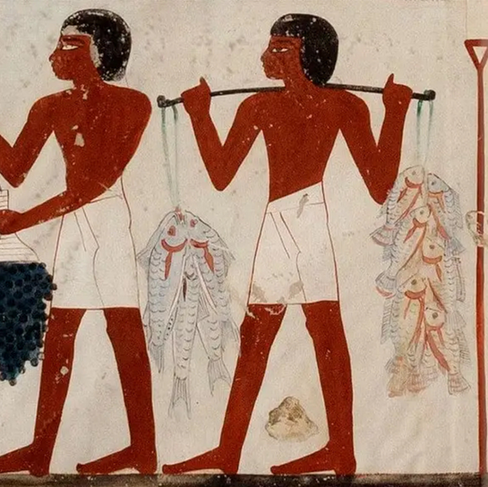Over December, I decided to have a little fun and create an advent calendar focusing on symbols of celebration in ancient Egyptian art. Each day I shared a different symbol and showed how it was used in different types of art to mark feasts, ceremonies and celebrations.
Jump to...

Perfume Cone
This intriguing cone is no ordinary decoration—it's a representation of perfume! Crafted from wax or fat and infused with myrrh, frankincense, and other aromatic oils, these perfume cones were often seen adorning the heads or held in hands during special events. As the cone gradually melted, it released a fragrant symphony, believed by the ancient Egyptians to be pleasing to the gods and possessing purifying and protective qualities.
There is plenty of artistic evidence supporting the existence of perfume cones in ancient Egypt but relatively few archaeological finds. Fragrant substances, including those possibly used in the form of perfume cones, were found in the tomb of Tutankhamun. Fragrance cones have also been found in the temple complex of Hatshepsut at Deir el-Bahari, Gurob in the Faiyum region and the ancient city of Akhetaten (Amarna), built by Akhenaten.
📷This image comes from the 18th Dynasty tomb chapel of Nebamun, originally in the Theban Necropolis and now in the British Museum EA37981.
Sistrum
A sistrum is a musical instrument consisting of a handle and a U-shaped frame with metal rods or loops strung across it. The metal components create a jingling sound when the instrument is shaken, and this distinctive sound was believed to have the power to ward off evil spirits and bring about the favour of the gods. It was commonly associated with the worship of goddesses, particularly Hathor, the goddess of music, dance, and fertility.
Numerous wall paintings, reliefs, and sculptures from ancient Egyptian temples and tombs depict individuals, both men and women, holding and playing the sistrum. Archaeological excavations have unearthed sistrums among the artefacts buried in tombs, with a notable example found in the tomb of Tutankhamun.
📷 This image comes from a fragmentary painting from a tomb in Deir el-Medina dating to c. 1250-1200 BC (New Kingdom), now in the collection of The Walters Art Museum (museum number 32.9).
Floral Collar
Floral collars were worn by priests, priestesses, and individuals participating in religious ceremonies to invoke divine favour and symbolise purity. Different flowers held specific symbolic meanings. For example, the lotus flower, which often appeared in these collars, symbolised rebirth, and the sun's journey across the sky. Other flowers, such as the blue water lily, had associations with the afterlife and resurrection.
Floral collars were frequently included in burial attire and tomb offerings and featured in religious rituals and offerings to the gods. While real flowers were used for temporary collars in certain ceremonies, more permanent versions were created using more durable materials like faience, precious metals, and gemstones.
📷 This image comes from the tomb of Djeserkareseneb (TT38) in Sheikh Abd el-Qurna dating to dynasty 18 of the New Kingdom.
Basket of Fruit
Baskets of fruit symbolise abundance, fertility, and prosperity and each variety of fruit carries its own symbolic and cultural significance. The representation of a plentiful harvest or a bountiful supply of fruit conveys the idea of wealth and well-being in ancient Egyptian society. In religious scenes, baskets of fruit are often presented as offerings to the gods as a symbol of gratitude and reverence. The gods were thought to be pleased by these offerings, and it was a way for individuals to seek favour or blessings.
In ancient Egyptian art, a variety of fruits are depicted including grapes, pomegranates, figs, dates, sycamore figs, dom palm nuts (eaten raw or steeped to make juice), nabk berries and mimusops. They are shown in baskets, platters or as piles on offering tables in scenes of everyday life and religious ceremonies. Whilst species can be inferred from the artistic depictions, we also have real examples of fruit preserved in tombs due to their dry, stable climates.
📷 This image comes from a painting in the Tomb of Menna (TT 69), located in Sheikh Abd el-Qurna, part of the Theban Necropolis. It is the burial place of the ancient Egyptian official named Menna, whose titles included ‘Overseer of Fields of Amun’ and dates to the reign of Tuthmosis IV and Amenhotep III in Dynasty 18.
Gold
Gold was highly valued and extensively depicted in ancient Egyptian art. It was a symbol of wealth, prestige, and status; the more gold a person possessed, the higher their perceived status in society was. It could be used for trade, craftsmanship, or as a form of currency and was often given by kings as rewards to their subjects.
On a spiritual level, gold was considered to be the "flesh of the gods" and the use of this precious metal in religious art and artefacts was a way to honour and emulate the divine. Its incorruptibility and everlasting brilliance linked it to the concept of immortality, and it was used in funerary contexts to create burial masks, coffins and objects to symbolise the eternal nature of the soul.
📷 This image comes from a relief on display at Rijksmuseum (museum number: H.III.PPPP), taken from the non-royal tomb of Horemheb in Saqqara dating to c. 1321-1293 BC. It portrays Horemheb, the commander of armies during Tutankhamun's reign, receiving gold neck rings and gifts from the royal family in Akhetaten (Amarna).
Plucked Goose
Geese were domesticated in ancient Egypt primarily for their meat, eggs, and feathers. They were a valuable food source, and scenes of geese being raised and prepared for consumption are common in Egyptian art. Scenes of plucked geese were commonly found in depictions of feasts and celebrations and were likely a delicacy served during special occasions and festivals.
Geese, both alive and plucked, were included in the food offerings made to the gods as a gesture of gratitude and to ensure divine favour and protection. In one version of the ancient Egyptian creation myth, it was believed that a goose called Ngg wr ‘The Great Honker/Cackler’ fathered the primordial egg from which the sun was ‘hatched’.
📷 This image shows a servant preparing and plucking geese for consumption. It comes from the walls of the Tomb of Nakht and his wife Tawy (TT52) in Sheikh Abd el-Qurna in the Theban Necropolis. This is the burial place of an ancient Egyptian official who held the position of a scribe and astronomer of Amun and dates to the reign of Tuthmosis IV and Amenhotep III in c. 1400-1352 BC (Dynasty 18).
Board Games
The three most popular board games played in ancient Egypt were Senet, Mehen and Hounds and Jackals. They were played for entertainment by people of all classes but also held symbolic associations with religious beliefs and the afterlife. Senet in particular was thought to mirror the challenges and progress of the soul in the afterlife. Gaming boards and pieces were often placed in tombs, and scenes depicting individuals playing them can be found in tomb paintings.
Some notable examples of gaming boards, gaming pieces and knuckle bones (used as dice) have been found in tombs, but no comprehensive set of rules has been discovered. They are all assumed to involve a combination of strategy and luck.
📷 This image shows a man called Sennedjem sitting before a table holding a Senet gaming board, with his wife Iyneferti beside him. It is part of a door which comes from Sennedjem’s tomb (TT1) in Deir al-Medina, dating to Ramesses II's reign (c. 1279-1212 BC, Dynasty 19), and now resides in the Egyptian Museum in Cairo (museum number JE 27303).
Wine
Wine was considered a luxury item in ancient Egypt and the ability to produce and consume wine was linked to wealth and affluence. In art, it frequently appears in festival scenes, either being made, drunk or stored in tall pottery jars. As well as being used to enhance the enjoyment of special events, wine also played a role in religious ceremonies and rituals, where it was often offered as a libation (a liquid offering) to the deities.
Wine, like other offerings, had a place in funerary rituals. The fermentation process, which turned grapes into wine, represented a transformative process and this was sometimes associated with religious beliefs about life, death, and rebirth. It was presented as an offering to the deceased in tombs, symbolising sustenance, and provisions for the afterlife. The deceased were believed to continue their existence in the afterlife, and offerings like wine were intended to ensure their ongoing well-being.
📷 This image shows the stages of wine production, from picking the grapes from the vines and crushing them underfoot to release the juices, to putting them into pottery jars and making records of the vintage. It can be found on the walls of a tomb in the Theban Necropolis belonging to a royal scribe called Userhat and his wife Mutnefret (TT56), who lived during the reign of Amenhotep II in Dynasty 18.
Dancing
Dance held profound significance in ancient Egyptian culture. Dance groups were a common sight at dinner parties, banquets, and within the sacred halls of religious temples. Professional ensembles, comprising singers (ḥsı͗t), musicians (ḥnı͗t or ḥnwt), and dancers (ḥbw), often performed at important festivals and funerary services. Wealthy harems even trained women in music and dance, with performances accompanied by male musicians playing instruments like guitars, lyres, and harps.
As it was considered inappropriate for the well-bred to dance publicly—an activity reserved for the lower classes—the wealthy elite employed slaves to provide entertainment at their gatherings. In artistic representations, these dancers are depicted in naturalistic and lively poses, adorned with nothing more than belts and jewellery, contrasting with the more restrained and dignified postures of their affluent spectators.
📷 A group of girls are performing to the accompaniment of clapping and finger-snapping during a festival dance in honour of the goddess of music and dancing, Hathor. It comes from a fragment of a wall painting from the Tomb of the Dancers (Tomb A.2) in Dra Abu el-Naga in Thebes dating c. 1630-1540 BC (Dynasty 17). The fragment is now in the Ashmolean Museum, Oxford.
Fine Linen
Linen was a light, breathable fabric woven from the fibres of the flax plant, and it held cultural importance in ancient Egypt. The process of producing linen involved several labour-intensive steps, including planting, harvesting, retting, spinning, and weaving. The resulting fabric was highly valued, and wearing linen represented wealth, cultural pride and sophistication.
Fine linen was associated with purity and cleanliness, making it suitable for depictions of individuals involved in religious rituals or interactions with deities. Priests, for example, were often shown wearing fine linen during special occasions, ceremonies, and rituals. Over time, the portrayal of elite individuals in fine linen became a stylistic norm in ancient Egyptian art, associating them with not only wealth but also religious piety.
📷 The lavishly dressed noblewoman Tjepu wearing a semi-transparent, fringed linen dress consisting of a white diaphanous shawl over an undergarment which leaves one breast bare. At the age of 40, she was immortalised as eternally youthful on the walls of the tomb of her son Nebamun and a man named Ipuky in Thebes dating to the reign of Amenhotep III in c. 1390-1353 BC. Now in the Brooklyn Museum (accession number 65.197).
Bread
Scenes of bread production, baking, and consumption were common in depictions of daily life and reflected the importance of bread in everyday existence. Depictions of abundant food offerings were used to convey affluence and well-being, and feasts and religious celebrations also included the presence of bread, emphasising its role in communal and celebratory gatherings.
Bread was associated with the goddess Isis, who was connected to fertility and motherhood and bread offerings were made in religious ceremonies and rituals dedicated to various deities. Scenes of offering bread were often depicted in tomb paintings and burial contexts and symbolised provisions for the afterlife, ensuring that the departed soul had sustenance on its journey.
📷 Tia, the nurse of the Akhenaten’s daughter Ankhesenpaaten, holding small loaves of bread to the young princess before her. It probably comes from Akhetaten (Amarna) and dates to c. 1353–1336 BC. It can now be found in the Metropolitan Museum, New York (Accession Number: 1985.328.5).
Lotus Flower
Lotus flowers were commonly featured in religious rituals and offered as gifts to deities in temples and tombs. Shown as buds and flowers held in bunches or worn on headdresses by festivalgoers during celebrations, they were also believed to possess healing properties. Fragrances extracted from lotus flowers were used in various cosmetic and ritualistic practices.
Lotus flowers, typically found in aquatic environments like ponds and slow-moving water, can emerge from the mud and bloom into beautiful and pristine flowers. This characteristic made them powerful symbols of rebirth, regeneration, and the cyclical nature of life in ancient Egypt. The blue lotus (Nymphaea caerulea) was associated with the primordial waters of Nun, the source of all creation. The lotus rising from these waters symbolised the emergence of life and the birth of the world. The lotus is also the symbol of the god Nefertem, embodying concepts of beauty and perfume.
📷 Ani in a lotus flower collar and his wife Tutu with a lotus flower headband, bouquet and headdress present offerings to the gods. This image comes from the Book of the Dead of Ani, dating from c. 1250 BC, now in the British Museum (museum number EA10470,36).
Meat
Representations of legs of meat was often associated with scenes of feasting, banquets, and celebrations in ancient Egyptian art. Depicting abundant and lavish food items, including meat, conveyed a sense of wealth, prosperity, and well-being. Meat, being a significant source of protein and sustenance, symbolised life and nourishment. Scenes showing the consumption of meat, especially during feasts and celebrations, reinforced the idea of abundance and the importance of food in sustaining life.
Legs of meat, along with other food items, were included in funerary practices. In tombs and burial sites, scenes often depicted offerings of food to ensure the deceased had provisions for the afterlife. The inclusion of meat symbolised the continuity of sustenance in the afterworld. In religious art, scenes often depicted priests or individuals presenting various food items, including meat, as offerings to deities. These offerings were believed to please the gods and ensure their favour.
📷 An unnamed man is offering a leg of meat to the colossal figure of Abkaou, Director of Horned Animals. This image comes from the Stele of Abkaou, found in Abydos and dating to c. 2033-1963 BC (late Dynasty 11). It is now on display in room 636 of the Louvre Museum in Paris (accession number N 169).
Wigs
Wigs were a significant part of ancient Egyptian fashion. They came in various styles and lengths, and individuals could choose wigs based on personal preference or societal trends. Wigs were considered fashionable accessories and were used to signify social status, with the type of wig worn often indicating an individual's position in society. High-ranking officials and the elite class would wear elaborate and sophisticated wigs to demonstrate their wealth and standing.
Wigs were also worn during religious ceremonies and rituals. They were considered essential in maintaining purity and cleanliness, which were important aspects of religious practices. They were often depicted in funerary scenes and were buried with individuals to ensure a proper appearance in the afterlife. The wig symbolised continuity and completeness in the afterworld.
📷 This limestone relief shows a man at some sort of celebration, wearing an elaborate wig and lotus flower headdress and fine linen garments typical of the Late Period. It probably comes from a tomb in Saqqara dating to the Amarna period and is now on display in the Brooklyn Museum (Accession Number 36.261).
Music
Celebratory feasts, festivals and funerary services often included entertainment in the form of professional musicians known as ḥnı͗t or ḥnwt, who accompanied singers (ḥsı͗t) and dancers (ḥbw). They played three different types of instruments including stringed instruments like harps and lyres, wind instruments like flutes and double-reeded pipes, and percussion instruments like drums, tambourines, and rattles.
Music was an integral part of religious rituals and ceremonies and was believed to have a powerful impact on the spiritual realm. Musicians played during temple ceremonies, and specific hymns and songs were composed for religious occasions. Unfortunately, there is no preserved musical notation from ancient Egypt, so the exact melodies and compositions are unknown. However, scenes in tombs and temples depict musicians and provide clues about the instruments and settings.
📷 Two women from a group of musicians play a harp and a lute during a feast. This image comes from the Tomb of Rekhmire (TT100) at Abd el-Qurna in the Theban necropolis.
Beer
Beer was a common feature at communal celebrations, such as feasts, banquets, and festivals. These occasions often involved consuming food and drink, including beer, to foster a sense of community and shared joy. Scenes featuring abundant food and drink, including beer, were often used to convey affluence and well-being.
Beer was frequently presented as an offering to deities in religious ceremonies and rituals. It played a role in religious libations, where liquid offerings were made to honour and seek favour from the gods. Beer offerings were part of the rituals performed in temples and tombs. Making offerings to the dead was a way for the living to maintain a connection with the deceased and provide for their needs in the afterlife. Beer, being a common and valued beverage in ancient Egyptian society, held significance in these funerary practices.
📷 King Intef II presents a bowl of beer and a jug of milk to the god Ra and the goddess Hathor. This image comes from a funerary stela found at El Tarif in Thebes and dates to Dynasty 11, c. 2108–2059 BC. It is now on display in the Metropolitan Museum of Art 13.182.3.
Mandrake Fruit
Traditionally found around the northern and eastern part of the Mediterranean, the mandrake was imported into Egypt during Dynasty 18 and cultivated in the gardens of elite members of society. In feasting scenes, they are often shown being offered up to the mouth of a guest by another person. Despite its toxicity, the fruits were consumed and used in potions for their hallucinogenic and aphrodisiac effects. The ancient Egyptians associated the mandrake fruit with love and desire, using it as a symbol of sexuality in love poetry.
Both the plant and its yellow fruits quickly became prominent in art after their introduction. They adorned objects like cosmetic spoons, mummy masks, coffins, pottery, and floral collars. Painted representations of gardens on palace, tomb, and temple walls also featured mandrake fruits. Notably, mandrake fruits formed part of a garland found on the mummy of Tutankhamun and appeared in the floral garlands around his neck on decorated furniture.
📷 A finely dressed woman offers a mandrake fruit to another female guest at a feast. This image comes from a wall painting from the Tomb Chapel of Nebamun located somewhere in the Theban Necropolis, and now on display in the British Museum (accession number EA37986).
Singing
The ancient Egyptians enjoyed music in their daily lives, and scenes of people singing and playing musical instruments can be found in depictions of feasts and social gatherings of all classes. In art, figures engaged in singing are often shown with specific gestures and postures. The facial expressions and body language of the singers may convey the emotional aspect of the performance. The mouth may be open to represent vocalisation, and the position of the hands and body may suggest the act of singing or holding a musical instrument. In some cases, scenes include inscriptions or hieroglyphs that represent the lyrics or hymns being sung.
Professional singers were trained in the art of music and would perform at important events, including royal banquets, celebrations, and religious festivals. Temples had singers who performed hymns and chants dedicated to specific deities. The music and lyrics were believed to invoke the presence of the gods and create a sacred atmosphere. Singing was also an integral part of funerary practices. During funeral processions and ceremonies, mourners would sing hymns and perform rituals to honour the deceased. The belief was that the soul of the departed needed guidance in the afterlife, and music and singing were thought to provide spiritual support.
📷 Two women in fine linen and floral collars sing and clap their hands. This image comes from a wall painting in the Tomb of Nebseni dating to Dynasty 18, c. 1422-1411 BC.
Makeup
Cosmetics served practical purposes such as protection from the environment, the sun’s harsh glare and biting insects. The idealised beauty standards of the time for emphasised clear, smooth skin, and the use of cosmetics was seen as a way to achieve this aesthetic. Black kohl was used to outline the eyes and eyebrows, whilst oils and perfumes were applied to the body for fragrance. Henna was used to dye hair and nails, and pigments and powders were used for lip colour and to enhance facial features.
The application of makeup, especially around the eyes, was seen as a way to emulate the gods, who were always depicted with distinctive dark, outlined eyes. The act of applying makeup, especially for important religious ceremonies and rituals, was seen as a transformative and spiritually significant process. This linked makeup to religious devotion and a desire to connect with the divine realm. It was seen as so vital to daily life that individuals were often buried with cosmetic items so they could retain access to them in the afterlife.
📷 Queen Nefertari, Great Wife of Ramesses II, is depicted wearing elaborate black kohl eye makeup. This image comes from a wall painting from the Tomb of Nefertari (QV66) in the Valley of the Queens dating to Dynasty 19.
Jewellery
Wearing jewellery was part of the cultural traditions and norms of ancient Egyptian society. It was a way for individuals to express themselves, showcase their identity, and adhere to the prevailing fashions. A wide variety of jewellery was worn, including necklaces, bracelets, anklets, earrings, earplugs, rings, headgear, amulets, pectorals and toe-rings. Jewellery, particularly gold and precious gemstones, symbolised wealth, and social status, so the more elaborate and valuable the jewellery, the higher the perceived status of the individual.
Jewellery played a role in religious rituals and ceremonies. It was common to present offerings of jewellery to deities in temples, and religious leaders often wore specific jewellery items during ceremonies. Amulets were worn for protection and were often depicted in funerary contexts to safeguard the deceased in the afterlife. Individuals were often buried with their jewellery, and depictions of the deceased in tombs showcased the jewellery they would carry into the afterlife. It symbolised continuity and provision in the journey beyond.
📷 A man wears an elaborate beaded collar and amulet in the shape of a heart around his neck. This image comes from a wall relief from the Tomb of Ramose (TT55) from the Valley of the Nobles, dating to the reigns of Amenhotep III and Akhenaten in c. 1380-1360 BC (Dynasty 18).
Fish
The Nile River, a lifeline for ancient Egypt, teemed with various fish species like perch, tilapia, catfish, and mullet. Fishing provided a readily available and sustainable food source with a high nutritional value, and fish was a significant part of everyone’s diet. Festivals and special occasions often involved elaborate feasts, where fish were a prominent feature on the menu. Their inclusion symbolised not only the material prosperity of the community but also added a special touch to joyous gatherings.
Like many other elements of daily life, Fish held symbolic importance, aligning with the themes of joy and rejuvenation during festivals. They were associated with fertility and abundance, reflecting the cyclical renewal of life linked to the annual flooding of the Nile. During festive occasions, presenting fish as offerings to the gods became a ritualistic practice. This gesture conveyed gratitude, abundance, and the community's desire for divine favour and protection during important events.
Offerings of fish were made to deities in temples, and their consumption was part of religious ceremonies. Medjed (an elephantfish) were worshipped at Oxyrhynchus and associated with the goddess Hathor, the Nile perch with the goddess Neith, and the tilapia with the sun god Ra. There was even a goddess called Hatmehit (literally translated as "Foremost of Fish") from the Delta city of Djedet who was depicted in the form of a fish, or a woman with a fish headdress.
📷 A porter carries a freshly caught batch of fish, as depicted on the walls of a Dynasty 19 tomb. Tomb of Menna (TT69) in Sheikh Abd el-Qurna, part of the Theban Necropolis.
Bouquets
In the vibrant tapestry of ancient Egyptian art, the depiction of people holding bouquets of flowers is a captivating motif laden with symbolic significance. These floral arrangements, often composed of sacred blooms like lotus blossoms, transcended mere aesthetic beauty. Flowers, with their cyclical blooming and withering, symbolised the profound cycle of life, death, and regeneration. These bouquets were used in art to convey the enduring hope for life's continuity and regeneration, as well as to celebrate the abundance and beauty of nature.
Flowers symbolised a variety of concepts:
The Blue Water Lily was linked to the afterlife and resurrection, due to its habit of opening with sunrise and closing with nightfall.
Papyrus Flowers were associated with Lower Egypt and symbolised the marshy regions along the Nile. It often represented the unification of Upper and Lower Egypt.
Cornflowers represented rejuvenation and were associated with the goddess Hathor and its bright blue colour symbolised the sky and heavens.
Date Palm Blossom symbolised fertility, abundance, and victory and is often used in art to convey the idea of a bountiful harvest and prosperity.
Mimosa are known for their fragrant flowers, and it was often used in decorative contexts to symbolise delicate beauty and grace.
📷 A woman in a flowing white linen robe is presenting someone with flowers in one hand and clasping a bouquet in her other. This relief dating to Dynasty 18 is usually referred to as “a walk in the garden” and depicts an unknown pharaoh from the Amarna period and his queen. It is now in the Neues Museum number 15000.
Family
The family was a central unit in ancient Egyptian society, and one's identity was closely tied to their familial connections, so we often see individuals surrounded by family members in art. They believed family was not just a social structure but a divine institution, reflecting the cosmic order known as Maat which maintained stability and harmony in the world. The virtues of love, respect, and support within the family unit were seen as aligning with the principles of Maat, whereas any disruption or imbalance within the family was perceived as a deviation from Maat.
The depiction of familial scenes in art during celebrations and daily life was a manifestation of their understanding that a harmonious family life played a crucial role in upholding Maat on a larger scale. Festivals and special occasions were times of joy and celebration in ancient Egyptian society and scenes of celebration conveyed the positive and joyful aspects of communal life. In tomb art, these depictions not only celebrated the relationships and shared experiences of the deceased during their earthly life but also emphasised the importance of family unity in the afterlife. Scenes of family gatherings conveyed the hope for a blissful and connected existence in the realm beyond.
📷 Inherkhau reaches out to touch the hair of one of his children whilst his wife Wabet embraces him by the shoulders. This image comes from the Tomb of Inherkhau (TT359) in Deir el-Medina. It is the burial place of a Foreman who worked on royal building projects during the reigns of Ramesses III and Ramesses IV in Dynasty 19.
Gifts
During festivals and special occasions, gift-giving was a customary practice. People exchanged gifts as a gesture of goodwill and to strengthen social bonds. It was not only about the material value of the gift but also about the symbolic gesture and the act of giving itself. These gifts could range from simple items to more elaborate and valuable ones, depending on the occasion and the individuals involved. Items exchanged as gifts included jewellery made of precious metals and gemstones, fine linen and other quality fabrics, clothing, and decorative items with aesthetic value, such as statuettes, figurines, or decorative pottery.
Gift-giving was an integral part of religious practices. Individuals often presented offerings to deities in temples, including food, beverages, and other valuable items. Fragrant substances such as incense and perfumes were also offered to the gods and the pleasant scents were believed to attract and appease divine entities. These offerings were a way of seeking favour, protection, or blessings from the gods.
Gifts were also given to the dead as part of the funerary practices, with offerings placed in tombs to accompany the deceased in the afterlife. These included representations of tools, utensils, and other daily-life items made from clay or wood, personal items belongings to the deceased, such as jewellery, cosmetics, and clothing as well as figurines known as ushabtis that would act as servants. These offerings were considered essential for ensuring the well-being of the departed soul in the afterlife.
📷 A funeral procession of servants carrying items to the burial chamber. This image comes from a wall relief from the Tomb of Ramose (TT55) from the Valley of the Nobles, dating to the reigns of Amenhotep III and Akhenaten in c. 1380-1360 BC (Dynasty 18).
Feasting
Feasting scenes were a vibrant element in ancient Egyptian art, symbolising joy, abundance, and communal celebration. These depictions, found in temples, tombs, and artefacts, showcased the importance of shared meals in their culture. Banquets were not just about indulging in delicious food; they were a representation of social cohesion, prosperity, and divine blessings. The act of feasting was intertwined with religious and symbolic significance, often associated with offerings to deities and expressions of gratitude. The scenes weren't just about physical sustenance but also nourishing the spirit through the bonds of community and the divine.
Over the past 25 days, we’ve explored how artists captured these festive moments with meticulous detail, portraying well-dressed people enjoying elaborate meals, whilst musicians, singers, and dancers perform for them. In these scenes, we see tables containing a wide-ranging menu of treats, including meat, fruit, bread, and cakes as well as jugs of wine and beer to drink. The guests wear fine linen, are anointed with sweet-smelling perfume, and wear elaborate makeup, jewellery, wigs, and floral collars.
📷 A servant offers two women a silver bowl at a feast in the afterlife. This image comes from the Dynasty 18 tomb chapel of Nebamun, originally in the Theban Necropolis and now in the British Museum EA37981.







